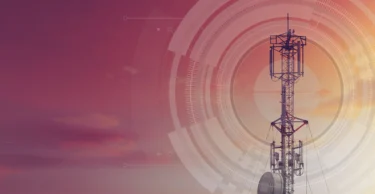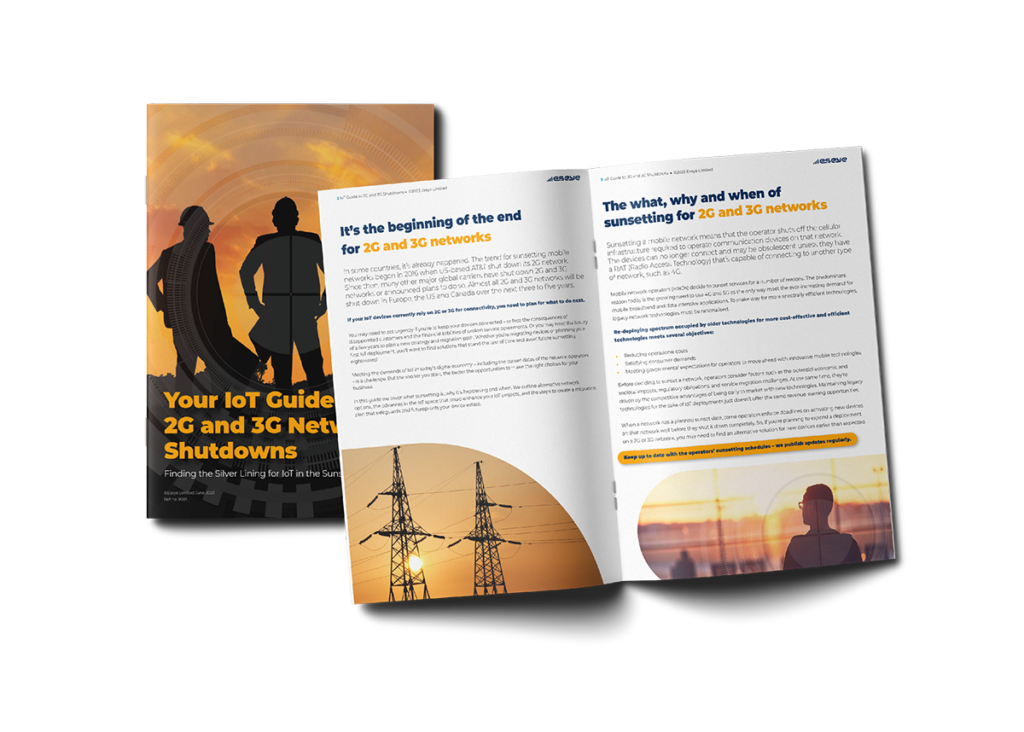
IoT Guide to 2G and 3G Network Shutdowns
Finding the Silver Lining for IoT in the Sunsetting Clouds

Finding the Silver Lining for IoT in the Sunsetting Clouds
In some countries, it’s already happened. The trend for sunsetting mobile networks began in 2016 when US-based AT&T shut down its 2G network. Since then, many other major global carriers have shut down 2G and 3G networks or announced plans to do so. Almost all 2G and 3G networks will be shut down in Europe, the US and Canada over the next three to five years.
If your IoT devices currently rely on 2G or 3G for connectivity, you need to plan for what to do next.
You may need to act urgently if you’re to keep your devices connected – or face the consequences of disappointed customers and the financial liabilities of broken service agreements. Or you may have the luxury of a few years to plan a new strategy and migration path. Whether you’re migrating devices or planning your first IoT deployment, you’ll want to find solutions that stand the test of time and avoid future sunsetting nightmares!
Meeting the demands of IoT in today’s digital economy – including the sunset dates of the network operators – is a challenge. But the sooner you start, the better the opportunities to make the right choices for your business.
In this guide we cover what sunsetting is, why it’s happening and when. We outline alternative network options, the advances in the IoT space that could enhance your IoT projects, and the steps to create a migration plan that safeguards and futureproofs your device estate.

Sunsetting a mobile network means that the operator shuts off the cellular infrastructure required to operate communication devices on that network. The devices can no longer connect and may be obsolescent unless they have a RAT (Radio Access Technology) that’s capable of connecting to another type of network, such as 4G.
Mobile network operators (MNOs) decide to sunset services for a number of reasons. The predominant reason today is the growing need to use 4G and 5G as the only way meet the ever-increasing demand for mobile broadband and data intensive applications. To make way for more spectrally efficient technologies, legacy network technologies must be rationalised.
Re-deploying spectrum occupied by older technologies for more cost-effective and efficient technologies meets several objectives:
Before deciding to sunset a network, operators consider factors such as the potential economic and societal impacts, regulatory obligations, and service migration challenges. At the same time, they’re driven by the competitive advantages of being early to market with new technologies. Maintaining legacy technologies for the sake of IoT deployments just doesn’t offer the same revenue-earning opportunities. When a network has a planned sunset date, some operators enforce deadlines on activating new devices on that network well before they shut it down completely. So, if you’re planning to expand a deployment on a 2G or 3G network, you may need to find an alternative solution for new devices earlier than expected.
For many businesses, a 2G or 3G network provides a secure, reliable, and cost effective connectivity solution for their IoT deployments. If you’re happy with your current network, you might wonder about switching to an operator that isn’t planning to sunset the service yet.
Switching operators, however, incurs administration and re-training costs. You may also find that operators increase telecom charges as competition dwindles in the 2G and 3G markets. And it’s only putting off the inevitable as the time will come when migration can’t be avoided. There are a number of other cellular network options available for IoT. The best choice depends on your business case requirements. The high bandwidth and performance offered by 4G and 5G are ideal if your devices need to transfer large amounts of data or latency is critical – and power usage isn’t an issue. But many IoT deployments have battery-powered devices that need coverage over a wide area and send small amounts of data infrequently.
NB-IoT and LTE-M are cellular Low Power Wide Area (LPWA) networks that have been designed specifically for low power IoT devices.
Specified by the 3GPP in releases 13 to 15, these networks are supported by major mobile equipment, chipset, and module manufacturers. The networks are now grouped under the umbrella term 5G massive MachineType Communications (5G mMTC). They benefit from the security, privacy, reliability, scalability, and regulatory oversight of licensed cellular networks.
Although part of the 5G family, the networks are designed to support simple, low-cost devices with low data throughput, rather than high bandwidth and low latency connections. Battery lifetimes of 10 years or more are possible using eDRX (Discontinuous Reception) and PSM (Power Saving Mode) features.
NB-IoT is best suited to devices that are stationary or have limited mobility, have low data throughputs and are tolerant of delays. It can support huge volumes of connections and has extended coverage, making it suitable for devices that are underground or in remote or inaccessible locations.
LTE-M supports roaming, higher data rates and lower latency requirements, making it better suited to more mobile or mission-critical IoT applications
By 2030, it’s estimated there will be 4 billion LPWA connections (up from 220 million in 2019), almost two-thirds of which will be 5G mMTC.1 The remaining third will use technologies such as LoRa and Sigfox that operate in non-licenced spectrum.
However, there’s some way to go before the 5G mMTC numbers are reached. Currently there’s a patchwork of offerings as operators roll out their NB-IoT and LTE-M networks. Initially LTE-M was deployed more extensively in the US, Canada, and Australia, while NB-IoT was more prevalent in China and Europe. Gradually, deployments and roaming agreements are increasing around the world, though it’ll be some time before there is global ubiquitous connectivity for either of these options.
As the LPWA networks are specifically designed for IoT devices, they offer more useful features and functionality for IoT than the networks they replace. And as they are part of the 5G family, there’s no danger of any sunsetting threats in the foreseeable future! Although availability can be patchy today, there are solutions if your chosen network isn’t currently offered everywhere you need it. Working with an experienced IoT connectivity partner can help you navigate this shifting landscape and provide advice on the best way forward
Before deciding to sunset a network, operators consider factors such as the potential economic and societal impacts, regulatory obligations, and service migration challenge"

Migrating an estate of thousands of devices from a 2G or 3G legacy network to
a different type of network requires time and careful planning.
For example, actions can include:
Migrating an estate of thousands of devices from a 2G or 3G legacy network to a different type of network requires time and careful planning."
IoT connectivity is a complex and ever-changing landscape. Eseye can take the pain and uncertainty out of your connectivity decisions, freeing you up to focus on business decisions and strategies.
The AnyNet+ SIM provides access to over 700 networks with one SIM. We pre-load multiple bootstrap IMSIs onto each SIM to ensure every device can connect out-of-the-box. Our multi-IMSI capability means that you only need one SKU, no matter where your devices will be deployed. With our Infinity IoT Platform™, we can monitor and manage IoT estates, ensuring that every device maintains near 100% connectivity. We can download new IMSIs to maintain connectivity or handle issues such as restrictions on permanent roaming.
The AnyNet+ SIM is compatible with 2G, 3G, 4G, 5G, NB-IoT and LTE-M networks. It delivers maximised cellular coverage across GSM and LTE networks, reinforced by our extensive global MNO interconnects. If your devices are enabled to work with different network technologies, AnyNet provides a futureproofed solution, ensuring that the devices can always connect.
With over 15 years of experience delivering IoT cellular connectivity, we have a wealth of experience and lessons learned from other IoT businesses in a whole range of technologies, geographies, and applications. We can provide up-to-date information on legislation and commercial regulations (for example, permanent roaming restrictions, device certification requirements for different network operators, and laws, such as GDPR, that govern protection and privacy for data in transit and storage). No two IoT deployments are the same. We offer solutions and best practices that meet your requirements and your situation. For example, we can explore how to keep your legacy devices connected to 2G or 3G networks while new devices come online or find ways to improve the connectivity performance of your devices before you start your migration. Our unique combination of offerings delivers a robust, high performing and futureproofed IoT connectivity solution for businesses. Contact us if you’d like to discuss your transition plan for managing a 2G or 3G sunset.
Eseye can take the pain and uncertainty out of your connectivity decisions, freeing you up to focus on business decisions and strategies. "
Jon Darley, Director of Things, Eseye.
Demand the best IoT partner for your project. Find out why global leaders onboard our technical expertise, from device design to development.